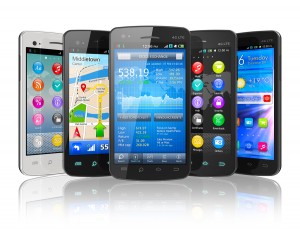Though they are still the biggest fish in the global electronics pond by any measure, and remain powerful and profitable, Apple Inc. (NASDAQ:AAPL) and its rival Samsung slipped below an important threshold during the first financial quarter of 2014. According to a report issued today by Strategy Analytics, the combined world market share of the two tech giants fell below 50% for the first time in years, signaling the slow but steady rise of second tier competitors.
This change represents a 3% fall in market share (in terms of millions of units sold) compared to figures from a year ago, in Q1 2013. Samsung naturally came out on top in the numbers game, shipping 31% of all smartphones sold on the planet during the quarter. Apple came in second with 15% of the volume. Of course, the vast majority of the profits were reaped by Apple, which is the world leader in producing hefty cash flows and staying firmly in the black.
 Huawei and Lenovo are the two companies next in line after Apple (AAPL) and Samsung, controlling about 4.7% of global market share apiece. Of the two, Lenovo is the more dynamic, having gained 1% of market share over the past year. It is also in the process of acquiring Motorola, which could either be an albatross around its neck, or else the springboard to controlling a bigger portion of the world market. A swarm of smaller manufacturers shipped a total of 44.1% of smartphones in Q1 2014.
Huawei and Lenovo are the two companies next in line after Apple (AAPL) and Samsung, controlling about 4.7% of global market share apiece. Of the two, Lenovo is the more dynamic, having gained 1% of market share over the past year. It is also in the process of acquiring Motorola, which could either be an albatross around its neck, or else the springboard to controlling a bigger portion of the world market. A swarm of smaller manufacturers shipped a total of 44.1% of smartphones in Q1 2014.
Samsung in particular is being squeezed by several different factors as the smartphone market continues to mature. The high end smartphone market is still the nearly exclusive bastion of the iPhone, which is still defying all attempts to dislodge it from this highly lucrative market sector. However, Samsung’s sales in the lower end sector are being rapidly eroded by the advance of small but determined competitors.
There is no real “middle ground” in smartphone sales – those too constrained to buy a high end phone (or in other words, Apple [AAPL]) will buy a cheap smartphone instead. As soon as income rises slightly, people are unwilling to settle for a middle of the road device; they will simply save up and buy a top end phone while using a cheap phone as a stopgap. Samsung has nowhere to go if it does not become more competitive in either the low end (where it is losing ground) or the high end (where it has always played a distant second fiddle to Apple).
Though Apple Inc. (AAPL) and Samsung are still the biggest smartphone sellers and will likely remain so for many years, the slip under 50% market share shows that the market is evolving. Eventually, powerful new rivals may emerge from the legion of small but energetic manufacturers who now ship 51% of humanity’s smartphones, to challenge the long-held dominance of these two monolithic electronics firms.



